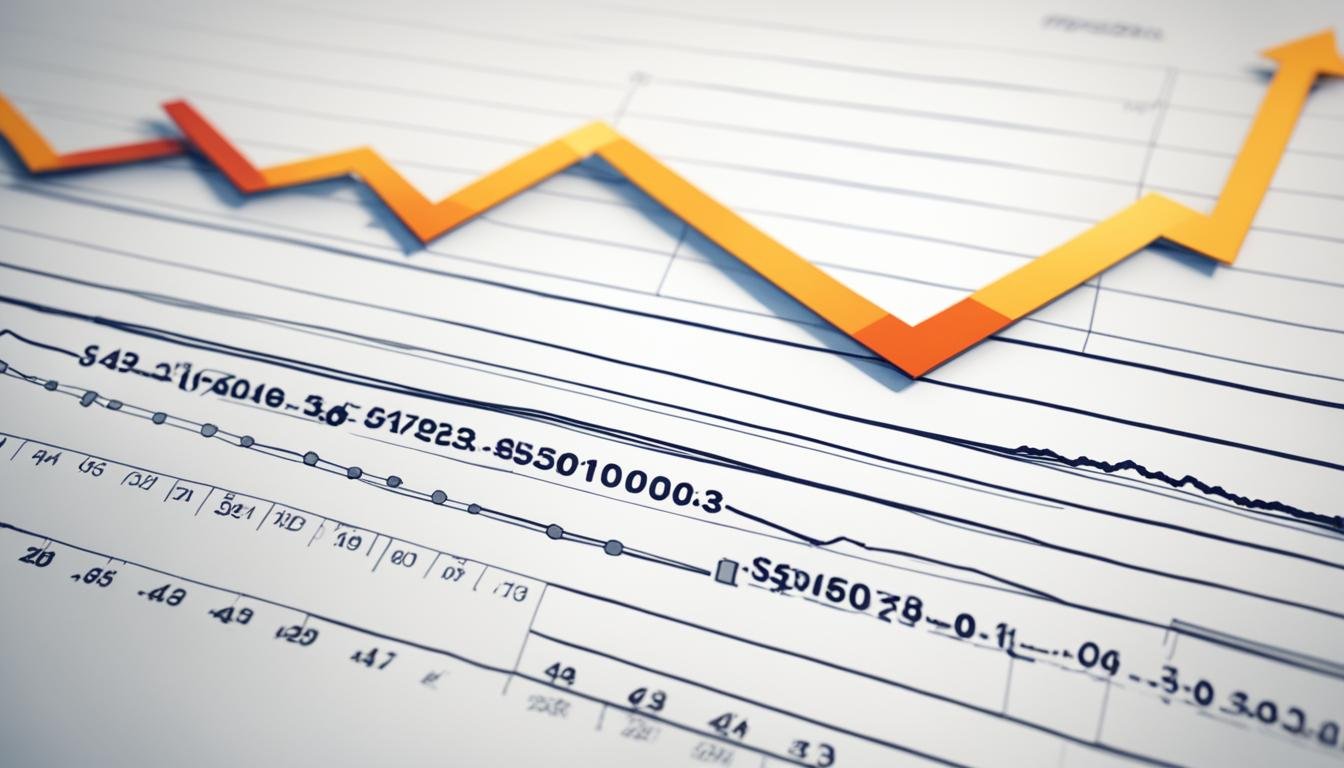Maximizing Returns: The Power of High Dividend Stocks
Are you looking for more than what market ups and downs can offer? High dividend stocks could be your answer. They provide a steady income and can increase your returns.
Dividend investing is a smart move. It gives you regular income and helps in growing your wealth over time. By choosing high dividend stocks, you enjoy not just bigger returns. You also get a consistent cash flow.
Key Takeaways:
- Dividend investing can provide a reliable source of income and long-term wealth accumulation.
- Investing in high dividend stocks can maximize your returns.
- High dividend stocks offer a steady cash flow for investors.
- Consider the potential of high dividend stocks to boost your overall investment portfolio.
- Explore the benefits of dividend investing and see the power of high dividend stocks in action.
Understanding the Power of Dividend Investing
Dividend investing involves buying stocks that pay dividends to shareholders. This strategy gives investors a steady income and the chance for stock value growth. Dividend stocks are great for those who want regular earnings from their investments.
One major plus of dividend stocks is the regular money they provide. These stocks pay out part of the company’s earnings regularly. This can boost other income sources or help grow your investments even more.
“Dividend investing offers the best of both worlds – consistent income and potential for capital appreciation. It is a strategy that suits investors looking for a reliable source of income while also benefiting from the long-term growth potential of the stocks they invest in.”
Dividend stocks also have the potential for price increases. So, investors can earn from dividends and also see their stock value rise. This mix of earning and growth is why dividend investing is so effective for long-term wealth.
Evaluating dividend stocks needs careful thought. Look at the company’s financial health, dividend history, and sector trends. With good research, investors can pick dividend stocks known for reliable performance and growth prospects.
Table: Dividend Stock Performance Comparison
| Company | Dividend Yield | Payout Ratio | Market Performance |
|---|---|---|---|
| Company A | 4.5% | 50% | +12% |
| Company B | 3.2% | 70% | +5% |
| Company C | 5.1% | 60% | +8% |
This table compares different dividend stock performances. It’s a good starting point for deeper research and analysis by investors.
Dividend stock investing also offers market stability. During market lows, dividends can help offset losses. This makes dividend stocks a safe harbor in stormy financial weather.
Knowing the benefits of dividend investing is key for smart investing. It offers regular income, growth potential, and stability in your portfolio.
Choosing High Yield Dividend Stocks
Choosing the right dividend stocks is crucial. Look for companies with a history of consistent dividend payments. Companies that consistently increase their dividends are called high yield dividend stocks. They are great for investors wanting strong returns.
High yield dividend stocks can give you a steady income. They often have higher dividend yields than other stocks. This means you could earn more on your investment.
Dividend growth stocks have a special appeal. They offer income and the chance for your investment to grow. Because they increase dividends over time, your portfolio could see substantial growth.
“Investors who focus on high yield dividend stocks and dividend growth stocks can benefit from a steady stream of income and the potential for long-term wealth accumulation.”
When choosing high yield dividend stocks, researching the company’s financial health is key. Look for strong cash flows and solid balance sheets. Ensure the dividend payout ratio is sustainable, so dividends can continue or even increase.
Diversifying your portfolio is also important for risk management. Spread your investments across various sectors. This strategy reduces the impact of negative events in any single sector on your overall returns.
Making smart choices with high yield dividend stocks involves analysis and strategy. Focus on companies with a reliable dividend history. Also, consider yield and growth, and diversify your dividends. This way, you can work towards securing strong returns and achieving your financial goals.
Top Dividend Yield Stocks
| Company | Sector | Dividend Yield |
|---|---|---|
| Company A | Technology | 5.2% |
| Company B | Consumer Goods | 4.8% |
| Company C | Healthcare | 4.5% |
| Company D | Utilities | 4.2% |
| Company E | Financial | 4.0% |
Diversifying Your Dividend Portfolio
Spreading your investments out is key when it comes to dividend investing. By doing this, you avoid putting all your eggs in one basket. This means you won’t rely too much on one company or sector. Diversifying lets you aim for better returns while keeping risk low. Adding dividend stocks from different sectors ensures a stable income and potential growth.
The Benefits of Diversification
Investing in various sectors spreads your risk. It protects your portfolio from downturns in any single area. This means if one sector, like healthcare, takes a hit, your overall income won’t suffer too much.
If your investment in healthcare drops due to regulatory issues, it could hurt your returns. But if your investments are spread out, the effect of one bad apple is lessened. This makes your dividend income more reliable.
Choosing Dividend Stocks from Different Sectors
It’s important to pick dividend stocks wisely. Look for companies with a good history of dividend payouts and growth potential. Thorough research on different sectors is crucial for this.
“Diversification is the key to long-term success in dividend investing. By spreading your investments across different sectors, you can minimize risk and maximize returns.” – Financial Expert
Different industries grow at different rates, influenced by economic changes. Investing across sectors helps you navigate these ups and downs. This way, you can benefit from growth in multiple areas.
Tracking Dividend Stock Performance
Keeping an eye on how your dividend stocks are doing is vital. Watch their dividend yield, payout ratio, and growth rates closely. This helps you make better investment choices. Staying informed ensures your portfolio keeps meeting your financial goals.
The Power of Dividend Reinvestment
Dividend reinvestment can majorly boost the growth of an investment portfolio over time. By putting dividends back into the same stock or other dividend-paying stocks, investors can see their returns grow. This approach uses the magic of compounding.
By reinvesting dividends, investors grow their investment in dividend stocks. This leads to bigger future dividends. It’s a smart move for those wanting growth and income over time.
Continual reinvestment means your initial investment and the reinvested dividends earn more dividends. This can greatly increase your portfolio’s growth. It shows the power of compounding.
Dividend reinvestment keeps investors investing instead of spending their dividends. Automatic reinvestment means your money keeps working for you. This can be very useful when the market is unpredictable.
“Dividend reinvestment is like planting a money tree that continues to grow and bear fruits over time.”
Investors can use different ways to reinvest dividends. Many brokers offer plans (DRIPs) for automatic reinvestment at a possibly lower price. Or, investors can choose to reinvest dividends on their own through their brokerage account.
Reinvesting dividends might lead to owning fractional shares due to stock prices. Yet, these fractions add up and help grow your portfolio over time.
The Benefits of Dividend Reinvestment
Dividend reinvestment offers several advantages:
- It allows investors to compound returns, leading to possible significant portfolio growth.
- Investors can slowly own more of the stocks, aiming for larger dividends later on.
- It’s automatic and easy through DRIPs offered by brokerage firms.
- This strategy can bring stability and help in building long-term wealth.
Example of Dividend Reinvestment:
Let’s look at how dividend reinvestment works in real life.
Imagine Investor A buys 100 shares of XYZ Company at $10 each, with a 4% annual dividend. Instead of taking the dividends in cash, they reinvest them in more XYZ stock.
After a year, besides the initial 100 shares, reinvested dividends got Investor A 10 more shares. If the price per share stays the same, they now have 110 shares of XYZ Company.
Next year, with a 4% dividend yield, Investor A gets dividends on 110 shares. The total dividend is $44 ($0.40 x 110). By continually reinvesting dividends, Investor A boosts their shares and overall dividends. Over years, this can lead to a big increase in portfolio value.
Dividend reinvestment is a strong strategy for boosting long-term investment returns. Through compounding and reinvesting dividends, investors can achieve great success in dividend stocks.
Assessing Dividend Yield and Payout Ratio
When you look at dividend stocks, two things are really important: the dividend yield and payout ratio. They help you see what you might earn back. They also show if a company can keep paying its dividends.
Thinking about the dividend yield is key in picking dividend stocks. You get it by dividing the annual dividend by the stock’s price. A higher yield means you could earn more. It also shows the company gives out a lot of its earnings as dividends.
But, don’t just go for stocks with high dividend yields right away. A really high yield might mean the stock price has dropped a lot. This could point to financial troubles or an unsustainable dividend payment. So, it’s important to look closer and think about other stuff before you invest.
The payout ratio tells us how much of their earnings companies give to shareholders as dividends. A lower payout ratio means the company keeps more for investing in itself. A higher ratio shows it’s giving out a lot of its profits as dividends.
Companies need to have a payout ratio that they can keep up with. This lets them continue to pay dividends, maybe even raise them later. Companies with conservative payout ratios can get through tough times better. They can also spend on growing and keep their dividend payments stable.
When you’re choosing dividend stocks, it’s smart to look for both a good dividend yield and a sustainable payout ratio. A company that has both a moderate yield and a healthy payout ratio might be safer. It’s better than one with a super high yield but a risky payout ratio.
Evaluating Dividend Yield and Payout Ratio: A Guided Approach
Here’s a step-by-step way to look at dividend stocks:
- Start by finding some dividend stocks that fit your investing goals and how much risk you want to take.
- Study their dividend yields and payout ratios.
- See how their dividend yield compares to others in the same industry. Is it higher or lower?
- Look at the payout ratio. Is it a good range? Does it show the company is smart about its dividends?
- Check how solid the company’s money situation is. Have they been earning well? Are there any financial worries?
- Examine if the company has been raising its dividends over time.
- Think about outside stuff, like how the industry is doing and the overall economy.
- Talk to a financial advisor to make sure your choices fit your money goals.
By using this guide, you can pick dividend stocks wisely. You’ll build a portfolio that meets your investment goals.

Case Study: Maximizing Returns with Procter & Gamble
Procter & Gamble (P&G) is a perfect example of dividend investing success. It has a history of growing its dividends, making it a top pick for people looking for steady returns. By reinvesting dividends and keeping their shares over time, investors gain from regular income and stock value increase.
P&G has been increasing its dividends for more than sixty years. This shows its financial strength and dependable business strategy. Investors trust P&G for stable returns and growing their wealth over the long haul.
Investing in dividend stocks like P&G means getting regular earnings and the chance of the stock’s value going up. The mix of these incomes enhances returns over years, offering a steady money source while growing wealth.
People holding P&G shares for a long time have watched their investment’s worth go up a lot. The compounded returns from reinvested dividends are a big part of this growth.
“Dividend investing, especially with a solid company like P&G, leads to great returns over time. Reinvesting dividends lets investors make the most of compounding and grow their returns.”
P&G not only offers attractive dividends but also adapts well to market changes. Its excellent performance cements its status as a great choice for those focused on dividends.
Before picking dividend stocks, investors should check the company’s financial health and dividend history. Examining these aspects helps find great opportunities for making the most from dividends.
Performance Overview: Dividend Increases and Stock Price Appreciation
Here’s a look at how P&G’s dividends and stock value have grown over ten years:
| Year | Dividend Increase | Stock Price Appreciation |
|---|---|---|
| 2011 | 7% | 15% |
| 2012 | 4% | 8% |
| 2013 | 7% | 18% |
| 2014 | 7% | 11% |
| 2015 | 3% | 2% |
| 2016 | 4% | 12% |
| 2017 | 3% | 6% |
| 2018 | 3% | 9% |
| 2019 | 4% | 25% |
| 2020 | 6% | 9% |
The data shows P&G’s consistent dividend growth and reliable income for investors. Also, the company’s stock has kept performing well in the market. This mix of growing dividends and stock value means big returns for P&G’s long-term investors.
Through smart dividend investing in credible companies like P&G, investors can get the most from their dividends. This way, they build a strong, varied investment portfolio.
Tips for Successful Dividend Investing
For success in dividend investing, it’s critical to research and pick the right stocks. Here are key tips for boosting your strategy and stock performance. This will guide you in earning strong returns from your investments.
- Thoroughly research and analyze companies: Before putting money into dividend stocks, make sure you get how the companies work. Understand their financial health, how they do business, and their past performance in paying dividends. Look for those with a reliable record of giving dividends and raising them as time goes by.
- Monitor the financial health of your dividend portfolio: Keep an eye on your portfolio’s financials. Make it a habit to go through their financial statements and earnings reports. This is key to spotting risks or shifts that might affect their dividend-paying ability.
- Stay updated on market trends and economic conditions: Pay attention to what’s happening in the market and the broader economy. Interest rate changes, new regulations, or economic slumps can all hit dividend stock performance hard.
- Consider consulting with a financial advisor: If you’re new to this or need tailored advice, think about talking to a financial advisor. They’re skilled in dividend investing and can offer insights, assist in creating a diverse portfolio, and help steer through market ups and downs.
“Successful dividend investing mixes knowledge, deep research, and smart decisions. Use these tips to boost your chances of success and maximize your earnings.”
Remember, playing the long game is key in dividend investing. Patience and a clear plan are vital. These tips are designed to refine your approach. They aim to ensure a steady flow of income and the chance for your capital to grow.
The Advantages of Dividend Paying Stocks
Dividend-paying stocks are great for investors. They offer a steady income and the chance to grow your money. Plus, they’re usually less risky than stocks that don’t pay dividends. This makes them a good choice for those who don’t like taking big risks.
One big plus of dividend investing is the steady money it brings in. If you pick these stocks, you could get paid regularly, like every three months. This is especially helpful for folks needing extra cash during retirement. It gives a stable cash flow, which is reassuring when the market is unpredictable.
On top of giving income, dividend stocks can also increase in value. While they’re known for paying out money, the companies behind them often grow too. This means investors can enjoy both regular payouts and a rise in their investment’s value, leading to good overall returns.
“Dividend-paying stocks not only provide a reliable source of income but also have the potential for capital appreciation.”
Also, dividend stocks are typically safer than those not paying dividends. Companies paying dividends are usually established and financially solid. They tend to make steady profits. This makes dividend stocks less risky.
There are tax perks with dividend stocks too. In places like the U.S., the tax on dividend income can be lower than on other income or gains. So, you keep more of what you make.
Diversification is another key benefit. With a mix of dividend stocks from various sectors, you lower your risk. If one stock does poorly, another might do well, balancing things out. Diversification makes your investment safer amid market swings.
To wrap up, the perks of dividend-paying stocks include reliable income, growth potential, lower risk, and tax benefits. Adding them to a diverse portfolio can give you regular income, chances for growth, and less risk.
| Advantages of Dividend Paying Stocks |
|---|
| Reliable income |
| Potential for capital appreciation |
| Lower risk compared to non-dividend paying stocks |
| Potential tax advantages |
| Enhanced diversification |
Conclusion
Dividend investing is a smart way to get more returns and steady income. To do well, investors should learn about this approach. They need to pick high-yield stocks, spread their investments, put dividends back in, and look at important numbers like dividend yield and payout ratio. This way, they can aim for long-term wins.
High dividend stocks are appealing for those wanting steady cash and the chance for their money to grow. By choosing firms that regularly pay and increase dividends, investors can have a portfolio that keeps giving back.
Yet, picking dividend stocks needs thorough research and keeping up with company and market news. Consulting a financial pro in dividend investing can be a big help. They can fine-tune your plan and help reach your money goals.







